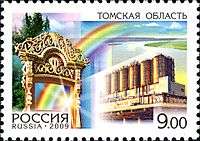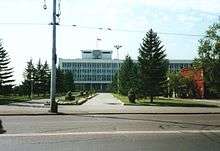Tomsk Oblast
| Tomsk Oblast Томская область (Russian) | |||
|---|---|---|---|
| — Oblast — | |||
| |||
| |||
|
| |||
| Political status | |||
| Country | Russia | ||
| Federal district | Siberian[1] | ||
| Economic region | West Siberian[2] | ||
| Established | August 13, 1944 | ||
| Administrative center | Tomsk | ||
| Government (as of March 2011) | |||
| • Governor | Sergey Zhvachkin[3] | ||
| • Legislature | Legislative Duma | ||
| Statistics | |||
| Area (as of the 2002 Census)[4] | |||
| • Total | 316,900 km2 (122,400 sq mi) | ||
| Area rank | 16th | ||
| Population (2010 Census)[5] | |||
| • Total | 1,047,394 | ||
| • Rank | 50th | ||
| • Density[6] | 3.31/km2 (8.6/sq mi) | ||
| • Urban | 70.2% | ||
| • Rural | 29.8% | ||
| Time zone(s) | KRAT (UTC+07:00)[7] | ||
| ISO 3166-2 | RU-TOM | ||
| License plates | 70 | ||
| Official languages | Russian[8] | ||
| Official website | |||
Tomsk Oblast (Russian: То́мская о́бласть, Tomskaya oblast) is a federal subject of Russia (an oblast). It lies in the southeastern West Siberian Plain, in the southwest of the Siberian Federal District. Its administrative center is the city of Tomsk. Population: 1,047,394 (2010 Census).[5]
The development of the territory which now constitutes the oblast began in the early 17th century. Tomsk itself was founded in 1604. Most of the oblast's 316,900 square kilometers (122,400 sq mi) territory is inaccessible because it is covered with taiga woods and swamps. Tomsk oblast contains Vasyugan Swamp, the biggest swamp in the northern hemisphere. The oblast borders with Krasnoyarsk Krai and Tyumen, Omsk, Novosibirsk, and Kemerovo Oblasts.
History

Long before Siberia became part of Russia, the territory of modern Tomsk Oblast was inhabited by people belonging to the taiga Kulayskoy civilization known for its bronze artifacts.
The development of the region began in the end of the 16th and early 17th centuries. The oldest settlement in the area is the village (former city) Narym, founded in 1596.
The administrative center of the province, the city of Tomsk, was founded in 1604. From 1719 to 1804 in the province of Tobolsk. In 1782, is formed by Tomskaya oblast in the composition of Tobolsky namestnichestva (from 1796 - Tobolskaya guberniya). In 1804 the Tomsk province was founded, which existed until 1925, when it became part of the Siberian region (since 1930 - the West Siberian region). Tomsk oblast was established August 13, 1944 by isolation from the Novosibirsk region of the districts and the former Narym District. On July 26, 1995 the Oblast's charter was adopted.
Politics

During the Soviet period, the high authority in the oblast was shared between three persons: The first secretary of the Tomsk CPSU Committee (who in reality had the biggest authority), the chairman of the oblast Soviet (legislative power), and the Chairman of the oblast Executive Committee (executive power). Since 1991, CPSU lost all the power, and the head of the Oblast administration, and eventually the governor was appointed/elected alongside elected regional parliament.
The Charter of Tomsk Oblast is the fundamental law of the region. The Legislative Duma of Tomsk Oblast is the province's standing legislative (representative) body. The Legislative Duma exercises its authority by passing laws, resolutions, and other legal acts and by supervising the implementation and observance of the laws and other legal acts passed by it. The highest executive body is the Oblast Government, which includes territorial executive bodies such as district administrations, committees, and commissions that facilitate development and run the day to day matters of the province. The Oblast administration supports the activities of the Governor who is the highest official and acts as guarantor of the observance of the oblast Charter in accordance with the Constitution of Russia.
Economy
Tomsk Oblast is rich in natural resources, particularly oil, natural gas, ferrous and non-ferrous metals, peat, and underground waters. Forests are also among the most significant assets of the oblast: about 20% of the West Siberian forest resources are located in Tomsk Oblast. Industry makes up about half of the regional GDP, while agriculture contributes 19% and construction 13%. Chemical and oil industries are the most developed in the region, followed by machine construction. The oblast's major export items are: oil (62.1%), methanol (30.2%), and machines and equipment (4.8%). Oil extraction and lumbering are the major business of the region's joint ventures.
Demographics
Population: 1,047,394 (2010 Census);[5] 1,046,039 (2002 Census);[9] 1,001,613 (1989 Census).[10]
Major ethnic groups living in the oblast are[5] Russians (92.1%), Ukrainian-Belorussian (1.4%), Siberian Tatars (1.7%) & Volga German (0.9%). Slavs, Finns and Germans make up more than 94.4% of the population, while Tatars, Chuvash, Armenes and Khants make up the remaining part. Additionally, 45,016 people were registered from administrative databases, and could not declare an ethnicity. It is estimated that the proportion of ethnicities in this group is the same as that of the declared group.[11]
After the disastrous situation during the 1990s, the demography of Tomsk Oblast is starting to get stabilized. During the first three months of 2009, there were 3,337 births (2.4% higher than that of 2008) and 3,339 deaths (6.7% less than that of 2008).[12]
- Births (2008): 13,372 (12.90 per 1000, higher than national average).[13][14]
- Deaths (2008): 13,403 (13.00 per 1000, lower than national average).
Birth rate for 2008 is 7.97% higher than that of 2007.
- Vital statistics for 2012
- Births: 14 384 (13.6 per 1000)
- Deaths: 12 632 (11.9 per 1000) [15]
Total fertility rate:[16]
2009 - 1.54 | 2010 - 1.49 | 2011 - 1.48 | 2012 - 1.55 | 2013 - 1.59 | 2014 - 1.59 | 2015 - 1.59(e)
Education
Science and education are also important for the regional development. The oblast is home to six state higher education institutions and 47 research institutes. Tomsk was the site of the first university in Asian Russian, founded in the 19th century. Since then city often dubbed the "Siberian Athens" for its unique spirit. Today more than 100,000 people (or 20 per cent of population of the city) study in Tomsk universities and colleges. In terms of the number of students per 10,000 people Tomsk is ranked third after Moscow and Saint-Petersburg. Tomsk Region is also ranked first in Russia in terms of the number of people engaged in R&D per capita with 160 researchers per 10,000 citizens.
Note: Data for Total fertility rate (2012) is estimate based on age and sex structure of Tomsk Oblast at the beginning of 2012, number of births in 2012 and fertility structure in previous years.[17][18]
Religion
According to a 2012 official survey[19] 33.3% of the population of Tomsk Oblast adheres to the Russian Orthodox Church, 4% are unaffiliated generic Christians, 2% is an Orthodox Christian believer without belonging to any church or is a member of other Orthodox churches, 1% adheres to the Slavic native faith (Rodnovery) or local indigenous Siberian folk religions, 1% adheres to Islam, 0.62% to Tibetan Buddhism, and 0.4% to the Catholic Church. In addition, 29% of the population declares to be "spiritual but not religious", 15% is atheist, and 13.68% follows other religions or did not give an answer to the question.[19]
Administrative divisions
Geography
Rivers
See also
References
- ↑ Президент Российской Федерации. Указ №849 от 13 мая 2000 г. «О полномочном представителе Президента Российской Федерации в федеральном округе». Вступил в силу 13 мая 2000 г. Опубликован: "Собрание законодательства РФ", №20, ст. 2112, 15 мая 2000 г. (President of the Russian Federation. Decree #849 of May 13, 2000 On the Plenipotentiary Representative of the President of the Russian Federation in a Federal District. Effective as of May 13, 2000.).
- ↑ Госстандарт Российской Федерации. №ОК 024-95 27 декабря 1995 г. «Общероссийский классификатор экономических регионов. 2. Экономические районы», в ред. Изменения №5/2001 ОКЭР. (Gosstandart of the Russian Federation. #OK 024-95 December 27, 1995 Russian Classification of Economic Regions. 2. Economic Regions, as amended by the Amendment #5/2001 OKER. ).
- ↑ Official website of Tomsk Oblast. Sergey Anatolyevich Zhvachkin (Russian)
- ↑ Федеральная служба государственной статистики (Federal State Statistics Service) (2004-05-21). "Территория, число районов, населённых пунктов и сельских администраций по субъектам Российской Федерации (Territory, Number of Districts, Inhabited Localities, and Rural Administration by Federal Subjects of the Russian Federation)". Всероссийская перепись населения 2002 года (All-Russia Population Census of 2002) (in Russian). Federal State Statistics Service. Retrieved 2011-11-01.
- 1 2 3 4 Russian Federal State Statistics Service (2011). "Всероссийская перепись населения 2010 года. Том 1" [2010 All-Russian Population Census, vol. 1]. Всероссийская перепись населения 2010 года (2010 All-Russia Population Census) (in Russian). Federal State Statistics Service. Retrieved June 29, 2012.
- ↑ The density value was calculated by dividing the population reported by the 2010 Census by the area shown in the "Area" field. Please note that this value may not be accurate as the area specified in the infobox is not necessarily reported for the same year as the population.
- ↑ Правительство Российской Федерации. Федеральный закон №107-ФЗ от 3 июня 2011 г. «Об исчислении времени», в ред. Федерального закона №271-ФЗ от 03 июля 2016 г. «О внесении изменений в Федеральный закон "Об исчислении времени"». Вступил в силу по истечении шестидесяти дней после дня официального опубликования (6 августа 2011 г.). Опубликован: "Российская газета", №120, 6 июня 2011 г. (Government of the Russian Federation. Federal Law #107-FZ of June 31, 2011 On Calculating Time, as amended by the Federal Law #271-FZ of July 03, 2016 On Amending Federal Law "On Calculating Time". Effective as of after sixty days following the day of the official publication.).
- ↑ Official on the whole territory of Russia according to Article 68.1 of the Constitution of Russia.
- ↑ Russian Federal State Statistics Service (May 21, 2004). "Численность населения России, субъектов Российской Федерации в составе федеральных округов, районов, городских поселений, сельских населённых пунктов – районных центров и сельских населённых пунктов с населением 3 тысячи и более человек" [Population of Russia, Its Federal Districts, Federal Subjects, Districts, Urban Localities, Rural Localities—Administrative Centers, and Rural Localities with Population of Over 3,000] (XLS). Всероссийская перепись населения 2002 года [All-Russia Population Census of 2002] (in Russian). Retrieved August 9, 2014.
- ↑ Demoscope Weekly (1989). "Всесоюзная перепись населения 1989 г. Численность наличного населения союзных и автономных республик, автономных областей и округов, краёв, областей, районов, городских поселений и сёл-райцентров" [All Union Population Census of 1989: Present Population of Union and Autonomous Republics, Autonomous Oblasts and Okrugs, Krais, Oblasts, Districts, Urban Settlements, and Villages Serving as District Administrative Centers]. Всесоюзная перепись населения 1989 года [All-Union Population Census of 1989] (in Russian). Институт демографии Национального исследовательского университета: Высшая школа экономики [Institute of Demography at the National Research University: Higher School of Economics]. Retrieved August 9, 2014.
- ↑ Перепись-2010: русских становится больше. Perepis-2010.ru (2011-12-19). Retrieved on 2013-08-20.
- ↑ За три месяца в Томской области заключено 1 583 брака - Новости России - ИА REGNUM. Regnum.ru (2009-04-16). Retrieved on 2013-08-20.
- ↑ Уровень рождаемости в 2008 году в Томской области почти сравнялся с показателями 1990 года - Новости России - ИА REGNUM. Regnum.ru (2009-01-14). Retrieved on 2013-08-20.
- ↑ Archived November 20, 2012, at the Wayback Machine.
- ↑ Естественное движение населения в разрезе субъектов Российской Федерации. Gks.ru. Retrieved on 2013-08-20.
- ↑ Каталог публикаций::Федеральная служба государственной статистики. Gks.ru (2010-05-08). Retrieved on 2013-08-20.
- ↑ БГД. Gks.ru. Retrieved on 2013-08-20.
- ↑ http://www.gks.ru/doc_2010/demo.pdf
- 1 2 3 Arena - Atlas of Religions and Nationalities in Russia. Sreda.org
- ↑ 2012 Survey Maps. "Ogonek", № 34 (5243), 27/08/2012. Retrieved 24-09-2012.
External links
| Wikimedia Commons has media related to Tomsk Oblast. |
 |
|
|
 | |
| |
|
| ||
| ||||
| | ||||
| |
|



